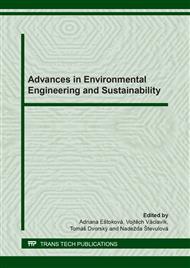[1]
C. Rösch, T. Kohajda, S. Röder, M. von Bergen, U. Schlink. Relationship between sources and patterns of VOCs in indoor air. Atmosph. Poll. Res. 5(1) (2014) 129-137.
DOI: 10.5094/apr.2014.016
Google Scholar
[2]
I. Mujan, A. S. Anđelković, V. Munćan, M. Kljajić, D. Ružić. Influence of indoor environmental quality on human health and productivity-A review. J. Clean. Prod. 217, (2019) 646-657.
DOI: 10.1016/j.jclepro.2019.01.307
Google Scholar
[3]
E. D. L. Patino, J. A. Siegel. Indoor environmental quality in social housing: A literature review. Build. Env.131 (2018) 231-241.
DOI: 10.1016/j.buildenv.2018.01.013
Google Scholar
[4]
L. Lucattini, G. Poma, A. Covaci, J. de Boer, M. H. Lamoree, P. E. Leonards. A review of semi-volatile organic compounds (SVOCs) in the indoor environment: occurrence in consumer products, indoor air and dust. Chem. 201 (2018) 466-482.
DOI: 10.1016/j.chemosphere.2018.02.161
Google Scholar
[5]
N. Mishra, J. Bartsch, G. A. Ayoko, T. Salthammer, L. Morawska. Volatile organic compounds: characteristics, distribution and sources in urban schools. Atmosph. Env. 106 (2015) 485-491.
DOI: 10.1016/j.atmosenv.2014.10.052
Google Scholar
[6]
Y. Huang, T. Su, L. Wang, N. Wang, Y. Xue, W. Dai, S. Ch. Lee, J. Cao, S. S. Ho. Evaluation and characterization of volatile air toxics indoors in a heavy polluted city of northwestern China in wintertime. Sci. Tot. Env. 662 (2019) 470-480.
DOI: 10.1016/j.scitotenv.2019.01.250
Google Scholar
[7]
E. D. Vicente, J. P. Ribeiro, D. Custódio, C. A. Alves. Assessment of the indoor air quality in copy centres at Aveiro, Portugal. Air Qual. Atmosph. Heal. 10(2) (2017) 117-127.
DOI: 10.1007/s11869-016-0401-8
Google Scholar
[8]
C. Zhou, Y. Zhan, S. Chen, M. Xia, C. Ronda, M. Sun, H. Chen, X. Shen. Combined effects of temperature and humidity on indoor VOCs pollution: Intercity comparison. Build. Env. 121 (2017) 26-34.
DOI: 10.1016/j.buildenv.2017.04.013
Google Scholar
[9]
W. Ye, X. Zhang, J. Gao, G. Cao, X. Zhou, X. Su. Indoor air pollutants, ventilation rate determinants and potential control strategies in Chinese dwellings: A literature review. Sci. Tot. Env. 586 (2017) 696-729.
DOI: 10.1016/j.scitotenv.2017.02.047
Google Scholar
[10]
J. Xu, M. Szyszkowicz, B. Jovic, S. Cakmak, C. C. Austin, J. Zhu. Estimation of indoor and outdoor ratios of selected volatile organic compounds in Canada. Atmosph. Env. 141 (2016) 523-531.
DOI: 10.1016/j.atmosenv.2016.07.031
Google Scholar
[11]
M. A. El-Hashemy, H. M. Ali. Characterization of BTEX group of VOCs and inhalation risks in indoor microenvironments at small enterprises. Sci. Tot. Env. 645 (2018) 974-983.
DOI: 10.1016/j.scitotenv.2018.07.157
Google Scholar
[12]
M. A. Bari, W. B. Kindzierski, A. J. Wheeler, M. È. Héroux, L. A. Wallace, Source apportionment of indoor and outdoor volatile organic compounds at homes in Edmonton, Canada. Build. Env. 90 (2015) 114-124.
DOI: 10.1016/j.buildenv.2015.03.023
Google Scholar
[13]
C. Norris, L. Fang, K. K. Barkjohn, D. Carlson, Y. Zhang, J. Mo, Z. Li, J. Zhang, X. Cui, J. J. Schauer, A. Davis, M. Black, M. H. Bergin. Sources of volatile organic compounds in suburban homes in Shanghai, China, and the impact of air filtration on compound concentrations. Chem. 231 (2019) 256-268.
DOI: 10.1016/j.chemosphere.2019.05.059
Google Scholar
[14]
S. Uchiyama, T. Tomizawa, A. Tokoro, M. Aoki, M. Hishiki, T. Yamada, R. Tanaka, H. Sakamoto, T. Yoshida, K. Bekki, Y. Inaba, H. Nakagome, N. Kunugita, Gaseous chemical compounds in indoor and outdoor air of 602 houses throughout Japan in winter and summer. Env. Res. 137 (2015) 364-372.
DOI: 10.1016/j.envres.2014.12.005
Google Scholar
[15]
V. Földváry, G. Bekö, S. Langer, K. Arrhenius, D. Petráš. Effect of energy renovation on indoor air quality in multifamily residential buildings in Slovakia. Build. Env. 122 (2017) 363-372.
DOI: 10.1016/j.buildenv.2017.06.009
Google Scholar
[16]
V. Kaunelienė, T. Prasauskas, E. Krugly, I. Stasiulaitienė, D. Čiužas, L. Šeduikytė, D. Martuzevičius. Indoor air quality in low energy residential buildings in Lithuania. Build. Env. 108 (2016) 63-72.
DOI: 10.1016/j.buildenv.2016.08.018
Google Scholar
[17]
C. R. O. Nunes, B. Sánchez, C. E. Gatts, C. M. de Almeida, M. C. Canela. Evaluation of volatile organic compounds coupled to seasonality effects in indoor air from a commercial office in Madrid (Spain) applying chemometric techniques. Sci. Tot. Env. 650 (2019) 868-877.
DOI: 10.1016/j.scitotenv.2018.09.095
Google Scholar
[18]
C. Mandin, M. Trantallidi, A. Cattaneo, N. Canha, V. G. Mihucz, T. Szigeti, R. Mabilia, E. Perreca, A. Spinazzè, S. Fossati, Y. Kluizenaar, E. Cornelissen, I. Sakellaris, D. Saraga, O. Hänninen, E. De Oliveira Fernandes, G. Ventura, P. Wolkoff, J. Bartzis. Assessment of indoor air quality in office buildings across Europe–The OFFICAIR study. Sci. Tot. Env. 579 (2017) 169-178.
DOI: 10.1016/j.scitotenv.2016.10.238
Google Scholar
[19]
F. Villanueva, A. Tapia, S. Lara, M. Amo-Salas. Indoor and outdoor air concentrations of volatile organic compounds and NO2 in schools of urban, industrial and rural areas in Central-Southern Spain. Sci. Tot. Env. 622 (2018) 222-235.
DOI: 10.1016/j.scitotenv.2017.11.274
Google Scholar
[20]
N. B. Goodman, A. Steinemann, A. J. Wheeler, P. J. Paevere, M. Cheng, S. K. Brown. Volatile organic compounds within indoor environments in Australia. Build. Env. 122 (2017) 116-125.
DOI: 10.1016/j.buildenv.2017.05.033
Google Scholar
[21]
J. Madureira, I. Paciência, J. Rufo, M. Severo, E. Ramos, H. Barros, E. de Oliveira Fernandes. Source apportionment of CO2, PM10 and VOCs levels and health risk assessment in naturally ventilated primary schools in Porto, Portugal. Build. Env. 96 (2016) 198-205.
DOI: 10.1016/j.buildenv.2015.11.031
Google Scholar
[22]
J. A. Becerra, J. Lizana, M. Gil, A. Barrios-Padura, P. Blondeau, R. Chacarteguia. Identification of potential indoor air pollutants in schools. J. Clean. Prod. (2019).
DOI: 10.1016/j.jclepro.2019.118420
Google Scholar
[23]
D. Norbäck, J. H. Hashim, Z. Hashim, F. Ali. Volatile organic compounds (VOC), formaldehyde and nitrogen dioxide (NO2) in schools in Johor Bahru, Malaysia: Associations with rhinitis, ocular, throat and dermal symptoms, headache and fatigue. Sci. Tot. Env. 592 (2017) 153-160.
DOI: 10.1016/j.scitotenv.2017.02.215
Google Scholar


